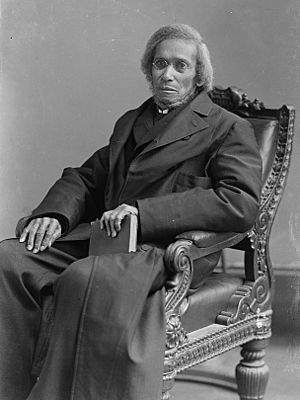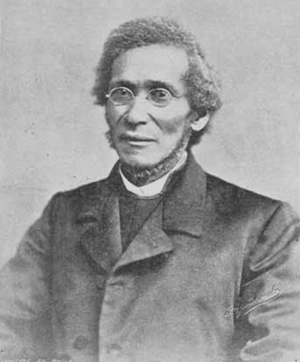Daniel Payne facts for kids
Daniel Alexander Payne (born February 24, 1811 – died November 2, 1893) was an important American leader. He was a bishop, teacher, college president, and writer. He helped shape the African Methodist Episcopal Church (A.M.E.), which is a large church for African Americans.
Payne believed that education was very important for church leaders. He helped make the church more organized. He became the sixth bishop of the A.M.E. Church in 1852 and served for over 40 years. He was also one of the people who started Wilberforce University in Ohio in 1856. In 1863, the A.M.E. Church bought the college. Payne became its president, making him the first African-American college president in the United States. He led the college until 1877.
After the American Civil War, Payne quickly helped the A.M.E. Church support freed people in the South. Because of his efforts, the church gained 250,000 new members during the Reconstruction era. He and his missionaries started many A.M.E. churches from Charleston, South Carolina all the way down the East Coast to Florida and west to Texas. In 1891, Payne wrote the first history of the A.M.E. Church. He also wrote his own life story a few years before that.
Contents
Early Life and Education
Daniel Alexander Payne was born free in Charleston, South Carolina, on February 24, 1811. His family had African, European, and Native American roots. He later wrote that his mother said her grandmother was from the Catawba Native American tribe. His father's family, the Goings, were well-known free people of color. His paternal grandfather was English.
Daniel's parents, London and Martha Payne, were part of the "Brown Elite" of free Black people in Charleston. Both of his parents died when he was young. His great-aunt took care of him, and a group called the Minors' Moralist Society helped with his early schooling. Payne grew up in the Methodist Church, like his parents. He also taught himself subjects like math, science, and old languages. In 1829, when he was 18, he opened his first school in Charleston.
After the Nat Turner Rebellion in 1831, southern states like South Carolina passed strict laws. These laws made it illegal to teach reading and writing to both free Black people and enslaved people. Because of this new law, Payne had to close his school on April 1, 1835.
In May 1835, Payne sailed north to Philadelphia to continue his education. He turned down an offer from the Methodists that would have sent him to Liberia in West Africa. Instead, he went to the Lutheran Theological Seminary at Gettysburg in Gettysburg, Pennsylvania. This seminary was only about ten years old at the time. Payne was ordained by the Lutheran Church in 1835. He was the first African American to be ordained by an American Lutheran church.
Some sources say he had to leave school because of problems with his eyesight. Others say he was not called to be a Lutheran minister. He was told to work with the Methodist Episcopal Church, which had many Black congregations. This led him to the African Methodist Episcopal Church.
Marriage and Family
Payne got married in 1847, but his wife passed away during their first year of marriage after childbirth. In 1854, he married again to Eliza Clark from Cincinnati.
Career in AME Church
By 1840, Payne started another school. In 1842, he joined the African Methodist Episcopal Church (AME). This church had been formed in 1816, splitting from the mostly white Methodist Episcopal Church. Payne believed, like the AME founder Bishop Richard Allen, that an independent Black church was a strong way to fight against slavery and racism.
Payne always worked to improve the lives of Black people in the United States. He did not support the idea of Black people moving to Liberia or other parts of Africa.
He worked hard to improve education for AME ministers. He suggested they study many subjects, like grammar, geography, history, and theology. He believed that well-educated ministers could better lead their communities. Payne also wanted to improve church music. He brought in trained choirs and musical instruments. He believed ministers should be able to read and write. Throughout his career, Payne helped build the church by creating literary and historical groups. He encouraged order in church services. Sometimes, he disagreed with those who wanted to keep worship styles more informal. This was especially true after the church grew in the South, where different worship traditions were common.
Bishop and College President
In 1848, Bishop William Paul Quinn named Payne as the historian of the AME Church. In 1852, Payne was elected and became the sixth bishop of the AME Church. He served as bishop for the rest of his life, until 1893.
Payne helped start Wilberforce University in Wilberforce, Ohio in 1856. He worked with other African Americans from the AME Church and white leaders from the Methodist Episcopal Church. The university was named after William Wilberforce, a British leader who worked to end slavery. Salmon P. Chase, who later became a Chief Justice of the U.S. Supreme Court, also supported the college. Wilberforce was the first historically black college where African Americans were part of its founding.
Wilberforce was built at a popular summer resort called Tawawa Springs. Before the Civil War, many of the college's students were mixed-race children of wealthy southern planters. These planters sent their children to Ohio for an education they could not get in the South.
When the Civil War started in 1861, the planters took their sons out of the college. The Methodist Episcopal Church also needed to use its money for the war effort. Because of these money problems, the college had to close for a short time. In 1863, Bishop Payne convinced the AME Church to buy the college. This made him the first African-American college president in the United States.
Two years later, a fire damaged the college buildings. Payne helped raise money and rebuild. Many people donated, including Salmon P. Chase and the United States Congress, which gave $25,000. Payne led the college until 1877. He also traveled to Europe twice to learn about British Methodist colleges and their education programs.
In April 1865, after the Civil War ended, Payne returned to the South for the first time in 30 years. He took nine missionaries with him to help establish the AME Church there. He organized missionaries, committees, and teachers to bring the AME Church to freed people. Just one year later, the church had grown by 50,000 members in the South.
By 1877, the AME Church had grown across the South, from Florida to Texas. More than 250,000 new members had joined. This growth in the South greatly influenced the national AME Church. It began to include more of the African-American culture and worship styles from the South.
In 1881, Payne started the Bethel Literary and Historical Society. This club invited speakers to talk about topics important to African-American life.
Bishop Payne passed away on November 2, 1893. He had served the African Methodist Episcopal Church for more than 50 years.
Works
- 1888, Recollections of Seventy Years, his life story.
- 1891, The History of the A. M. E. Church, the first history of the AME Church.
Legacy and Honors
|
Pennsylvania Historical Marker
|
|
| Location | 239 N. Washington St. at Gettysburg College |
|---|---|
| Coordinates | 39°50′04″N 77°14′00″W / 39.83448°N 77.23333°W |
| PHMC dedicated | March 10, 1991 |
A historian named James T. Campbell wrote that "No single individual, with the possible exception of Richard Allen himself, did more to shape the trajectory and tone of African Methodism." This means Payne was one of the most important people in shaping the AME Church.
Many things have been named in his honor:
- Daniel Payne College, a historically Black college in Alabama, was named after him. It operated from 1889 to 1979. After it closed, a street in Birmingham was renamed Daniel Payne Drive.
- Payne Theological Seminary in Wilberforce, Ohio, is named for him.
- A Pennsylvania State Historical Marker was placed at Gettysburg College to remember his studies there.
- He is honored on the Lutheran church calendar.
- Payne Elementary School in Washington, D.C., is named for him.



